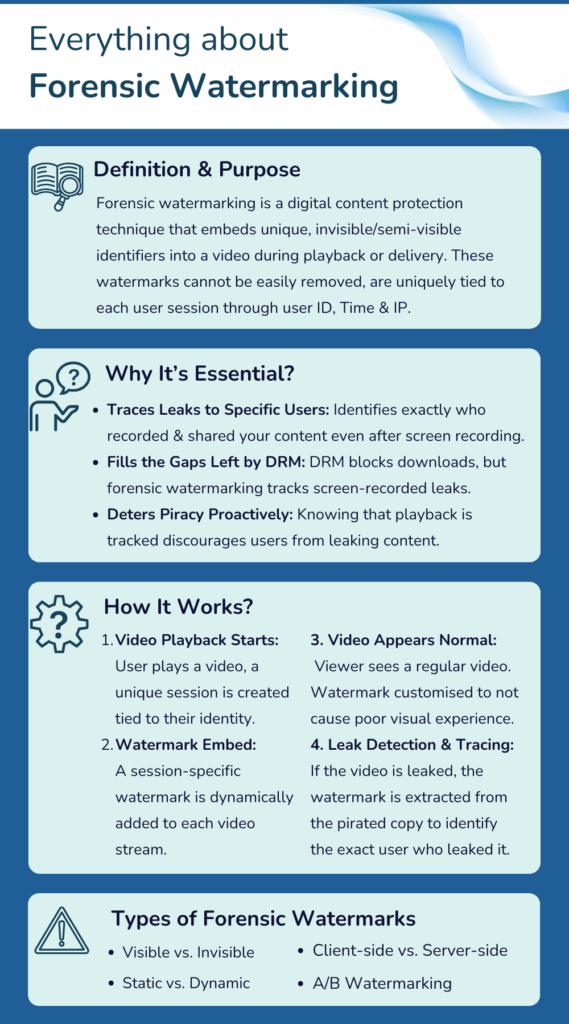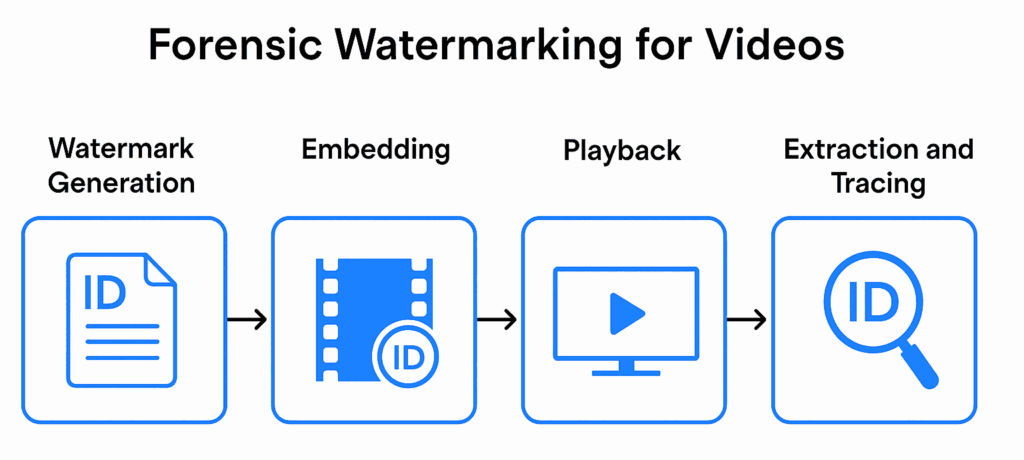In today’s digital-first world, forensic watermarking for video protection has become essential. As video content grows in value -across OTT platforms, e-learning, and corporate environments, piracy poses an increasing threat. Whether it’s pre-release screeners or premium courses, protecting videos from unauthorized distribution is more important than ever.
It’s no longer just about torrents or shady DVD vendors. Today’s pirates often sit inside the system—users, partners, even reviewers. They’re leaking premium content within hours, sometimes minutes. That’s where forensic watermarking comes in. Not flashy. Not loud. But quietly powerful.
In 2023, piracy cost the entertainment industry more than $50 billion. Over half of all internet users have, knowingly or unknowingly, consumed pirated material—most of it video. While DRM (Digital Rights Management) has made big strides, it can’t catch everything. That’s why companies – from indie educators to global OTTs—are embracing forensic watermarking as a second line of defense. Platforms like VdoCipher combine DRM with hacker identification, watermarking, and piracy blockers to create a multi-layered wall of security.
Table of Contents:
- Why Forensic Watermarking Is Needed?
- How Forensic Watermarking Works?
- Types of Forensic Watermarking
- Challenges of Forensic Watermarking
- Limitations of Forensic Watermarking
- Use-Cases of Forensic Watermarking
- What is A/B Forensic Watermarking?
- What the Future Looks Like for Forensic watermark?
- Forensic Watermarking Vs Traditional Watermarking
- Conclusion
- Forensic Watermarking FAQs
Why Forensic Watermarking Is Needed?
1. The Rise of Sophisticated Piracy
With high-speed internet and advanced downloading + hacking tools readily available, pirated content can be created and shared within hours of release—especially on online platforms like Telegram and Torrent.
2. DRM Has Its Limits
Digital Rights Management (DRM) solutions like Widevine and FairPlay control access and playback. However, they cannot prevent screen recordings or insider leaks. Also, Google Widevine DRM has been vulnerable since sometime now and thus DRM alone is not enough.
3. The Power of Traceability
Forensic watermarking doesn’t prevent piracy directly—it deters it by embedding unique, invisible markers into each video session. This enables identification of the original leaker, creating a legal and psychological deterrent.
How Forensic Watermarking Works?
Step 1: Generating Unique Signatures
Each viewer receives a uniquely watermarked version of the video based on parameters like:
-
User ID – This can be a string which does not reveal an identity directly ( not email/phone), but a user id parameter searchable at the platform backend database.
-
IP address and location
-
Device ID – A single user can be using multiple devices themselves or share their access.
-
Session timestamp – This is helpful to correlate the leakage of video to the actual time of recording. It is also helpful in initiating legal actions.
Step 2: Watermark Embedding/Integration
Watermarks can be embedded in 2 ways:
-
Pre-transcoding (each file rendered separately)
-
Real-time/on-the-fly (inserted during playback via CDN or player)
This can again have 2 options based on whether the watermark is on video CDN/encoding level or a frontend component over player.
Step 3: Seamless User Experience
The watermark remains invisible to viewers and does not affect video quality. It only surfaces during a piracy investigation.
Step 4: Extraction and Tracking
If a leak is discovered, forensic tools extract the embedded watermark. This fingerprint is then matched to a specific session or user account.
Types of Forensic Watermarking
| Visible vs Invisible | Visible watermarks (email, username) are obvious but removable. They can be made semi -visible by playing with frequency & transparency index.
Forensic watermarks are invisible and harder to tamper with. Downside is it is not enough of a discouragement. |
| Static vs Dynamic | Static watermarks remain unchanged. They are comparatively easier to remove.
Dynamic watermarks shift every few seconds, increasing tamper resistance. |
| Client-side vs Server-side | Client-side watermarks are applied during playback.
Server-side watermarks are embedded before delivery. |
Works Best When Paired:
Forensic watermarking isn’t a standalone solution—it’s part of a larger ecosystem.
- DRM (e.g., Widevine, FairPlay) ensures that encryption can not be broken and raw file can not be downloaded. Though DRM , especially Widevine DRM has faced vulnerabilities in recent times.
- Tokenized links, geo-fencing, watchtime limitation help control access, but don’t identify leaks.
- Screen-capture blocking tools try to prevent recording—watermarks help even when they fail.
Practical Challenges:
- Speed & Scale:
For live events or viral content, watermarking has to keep up in real time, across millions of users. - Anti-tamper Strength:
Good watermarking resists attempts to strip it—even if pirates re-encode, resize, or tweak frame rates. - Compatibility:
Older devices, browsers, or third-party apps might not support dynamic watermarking methods. - Resource Heavy:
Creating unique watermarked videos per user can be costly in terms of storage, processing, and delivery.
Limitations to Keep in Mind:
- It doesn’t block piracy—it tracks it. The system works after a leak happens, not before.
- Extraction isn’t instant. Pulling out and analyzing a watermark can take time— especially for long or low-quality leaks.
- If poorly executed, quality suffers. Low bitrates + badly placed watermark = unhappy viewers.
- Requires compatible video players. Some players or SDKs are needed for watermarking to function smoothly.
- It’s not cheap at scale. If you’re watermarking every session for millions of users, infra costs can balloon quickly.
- Legal proof requires more than just a watermark. To be court-admissible, you need tamper-proof logs and clean audit trails.
- Advanced pirates can still try tricks. Think overlays, heavy compression, frame warping. Today’s watermarking tech is resilient—but not bulletproof.
- DRM and watermarking are not substitutes.Watermarking can’t encrypt or restrict playback. It works best when paired with DRM, not instead of it.
Use Cases:
- OTT Platforms & Studios: Netflix, Disney+, Prime Video use watermarking for pre-release content, screeners, and test groups.
- E-learning Platforms: High-value courses can’t afford Telegram leaks. A single leak = thousands in lost revenue.
- Enterprise Communication: Internal videos, product demos, and investor briefings—leaked content can lead to lawsuits.
- Live Events & PPV Sports: Watermarking can be added dynamically during live playback—especially useful in detecting illegal rebroadcasts.
- Government & Defense: From secure broadcasts to confidential communication, these sectors need auditability more than anything.
What is A/B Forensic Watermarking?
A/B Watermarking is a robust session-based method where each short video segment exists in two slightly different versions (A & B). Each viewer receives a cryptographically generated sequence (e.g., AABBAB…) unique to their session. This sequence acts as a binary fingerprint for leak detection.
How It Works (Step-by-Step)?
- Pre-processing:
– The video is divided into short segments (e.g., 2 seconds each).
– Each segment is encoded twice: once as Version A and once as Version B. - Session ID Mapping:
– Each viewer gets a unique sequence of A/B choices (e.g., AABABBAB…), generated cryptographically.
- Streaming:
– The video player fetches either A or B segments based on the user’s assigned pattern. - Leak Detection:
– Forensic tools analyze a leaked video’s segment sequence and match it to a known pattern, identifying the original user.
Why Use A/B Dynamic Watermarking?
- High Security: The watermark is hidden and resistant to tampering.
- Attack Resilience: Segment patterns survive compression, re-encoding, and screen recording.
- Scalable: Supports millions of users with unique identifiers.
Specifications & Standards
A/B watermarking is guided by standards from organizations like:
- CDSA (Content Delivery & Security Association)
- MovieLabs
- ETSI (European Telecommunications Standards Institute)
Standard guidelines include:
- Segment length (typically 2–5 seconds)
- Unique session patterns with adequate Hamming distance
- Secure session ID mapping
- Integration with CDN and video player APIs
Real-world Usage
- OTT platforms like Netflix, Disney+, Apple TV+ for pre-release screeners
- Studios and post-production teams for secure internal sharing
- Enterprises for training content security
Limitations of Forensic watermarking:
- Requires dual encoding and storage for A/B segment versions
- Needs custom video player for playback patterning
- Offline or legacy device playback may not support A/B watermarking
What the Future Looks Like for Forensic watermark?
- AI-powered detection
Faster watermark tracing using neural networks and pattern matching. - Blockchain-based logs
Immutable watermark evidence that can be trusted in courtrooms and audits. - Edge watermarking
Processing closer to the viewer’s device—faster and more scalable. - Expansion to creator platforms
YouTube, Instagram, TikTok: watermarking may soon become common in UGC (User Generated Content). - Standardization efforts
Groups like W3C and MPEG are working to make watermarking easier to adopt across tools and platforms.
Forensic Watermarking Vs Traditional Watermarking
| Feature | Forensic Watermarking | Traditional/Digital Watermarking |
| Visibility | Invisible (imperceptible to human eye) | Can be visible (logos/text) or semi-visible |
| Primary Purpose | Trace source of piracy or leaks | Brand attribution, copyright notice, basic deterrence |
| Traceability | High – unique to each user/session | Low – same watermark for all copies |
| Tamper Resistance | High – robust against cropping, compression, re-encoding | Moderate – visible watermarks can be blurred or cropped |
| Integration Level | Deep integration with video players/CDN/DRM systems | Shallow – can be added during editing or encoding |
| Use Case | Anti-piracy and legal investigation | Branding and basic copyright enforcement |
| Watermark Generation | Dynamic – based on user/session/device parameters | Static – same watermark across all media |
| Extraction | Requires forensic tools for detection | Can be seen or heard without special tools |
| User Perception | No impact on viewing experience | Visible watermark may reduce perceived video quality |
| Legal Use | Stronger evidence in legal settings due to unique traceability | Weaker legal standing (if not tied to individual distribution) |
| Implementation Complexity | High – needs infrastructure for embedding, tracking, decoding | Low to medium – easily applied using editing tools |
Conclusion
Forensic watermarking has transitioned from a niche security mechanism to a mainstream requirement in the video delivery ecosystem. While it doesn’t prevent piracy outright, it acts as a strong deterrent by introducing traceability and accountability. For content creators, distributors, and platform operators, investing in a robust forensic watermarking solution is no longer optional—it’s essential.
As digital distribution continues to evolve, so will the sophistication of pirates. The fight against piracy is not about one-time fixes but layered, evolving defenses—and forensic watermarking is a vital layer in that strategy.
VdoCipher provides a visible or semi visible (almost transparent and small , non frequent) user-based client-side watermark to discourage screen capture and also detect piracy in case of screen capture based leakages. Free full version 30 Day trial is available at vdocipher.com
Forensic Watermarking FAQs
1. Is forensic watermarking visible to the viewer?
No. It’s designed to be invisible and does not interfere with the viewing experience.
2. Does it prevent piracy completely?
No. It doesn’t block piracy but helps trace the source after a leak has occurred.
3. Can pirates remove the watermark?
Highly unlikely. Modern forensic watermarks are robust against compression, cropping, and re-encoding.
4. Is forensic watermarking legal proof?
Yes—when paired with tamper-proof logs and a clear audit trail, it can serve as legal evidence.
5. Can I use watermarking without DRM?
Technically yes, but it’s not recommended. For maximum security, watermarking should complement DRM.
6. Does it work with live streams?
Yes. Dynamic watermarking can be applied in real-time during live playback.
7. What is the cost of implementing forensic watermarking?
Costs vary based on scale, delivery method, and infrastructure. Client-side watermarking is more cost-effective than server-side or dual-encoded A/B watermarking.
Supercharge Your Business with Videos
At VdoCipher we maintain the strongest content protection for videos. We also deliver the best viewer experience with brand friendly customisations. We'd love to hear from you, and help boost your video streaming business.




Leave a Reply